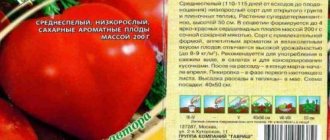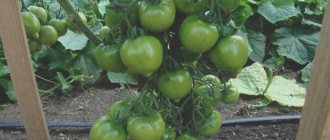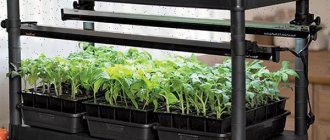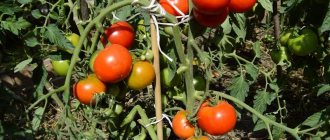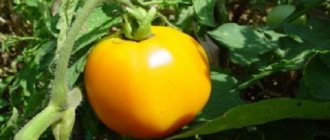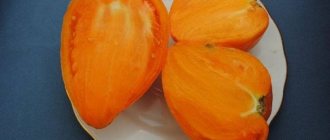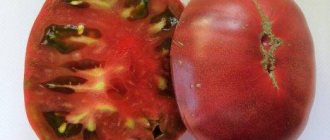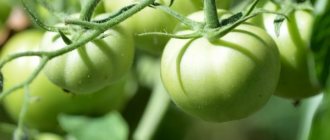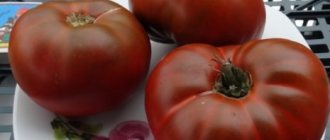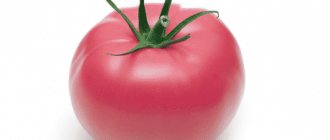Among the resistant hybrids intended for cultivation in open ground, the tomato Aviso f1 occupies a special place. Thanks to its abundant fruiting and pleasant taste, the tomato is popular among modern gardeners.
| Height | Landing location | Ripening time | Fruit color | Fruit size | Origin | Fruit shape |
| short | Open ground | Early ripening | Reds | Average | Hybrid | Plum-shaped or oval |
Nuances of care
Among the resistant hybrids intended for cultivation in open ground, the tomato Aviso f1 occupies a special place. Thanks to its abundant fruiting and pleasant taste, the tomato is popular among modern gardeners.
| Height | Landing location | Ripening time | Fruit color | Fruit size | Origin | Fruit shape |
| short | Open ground | Early ripening | Reds | Average | Hybrid | Plum-shaped or oval |
The variety is determinate, the plant is standard, early ripening, and does not require garters or fixing supports.
Intended for fresh consumption. They make excellent salads, sauces, juices and pastas. Suitable for whole fruit canning.
Pros:
- friendly rich harvest;
- do not require formation;
- resistance to late blight;
- ease of care;
- excellent taste;
- resistance to fungal diseases.
Minuses:
- the need for constant purchase of seeds;
- need regular feeding;
- unsuitable for long-term storage;
- underdeveloped root system.
Productivity
The hybrid is characterized by the simultaneous ripening of a large number of fruits. Productivity directly depends on the responsible care of the gardener for the plant.
Planting and care
Since the tomato is considered a first generation hybrid, once planted, the tomatoes do not produce seeds to produce the same fruit.
If agrotechnical conditions are violated, the richness of the crop decreases. You can water the plant exclusively with warm water, preferably early in the morning. The Avizo tomato is not demanding on moisture, so you should control the amount of water in the soil. It is recommended to loosen the soil from time to time.
Early maturing / Low-growing User rating: 5/5 Mid-early / Low-growing User rating: 5/5 Early maturing / Low-growing User rating: 5/5
Caring for tomatoes consists of hilling, loosening the soil,
and watering, bush formation and timely fight against
It is necessary to hill up tomatoes for the first time 9-11 days after planting the seedlings. Immediately before starting work, you need to water: hilling with damp soil will speed up the formation of new roots on the plant stem. The second hilling must be carried out 16-20 days after the first.
Tomatoes must be watered in the holes in a timely manner, water consumption is 0.7-0.9 liters per plant. The best time is the second half of the day and cloudy weather. Watering is required during the flowering period of the first and second clusters, before loosening the soil, after applying dry mineral fertilizers. Plants are undemanding when it comes to air humidity, but if it is too high, they can suffer from late blight and brown spot.
Alirin-B TAB 85 rubRussian Vegetable Garden Fitosporin-M universal 200 gr. (paste) 69 rubRussian Vegetable Garden Fitosporin-M universal 100 gr. (paste) 39 rubRussian Vegetable Garden Fitosporin-K Olympic nano-gel 69 rubRussian Vegetable Garden
During the summer, tomatoes need to be fed several times with mineral and organic fertilizers.
Bull's heart
A tomato with the proud name Eagle Heart occupies the bottom line of our top.
Everyone who grows these giant tomatoes with an elongated tip, shaped like a heart, leaves only positive reviews about it. The weight of the fruit reaches 600-800 g, and sometimes up to 1 kg. One such pink-raspberry fleshy “bug” - and you can feed the whole family with salad! The tomato pulp is sugary, juicy and sweet. The variety is determinate, has a medium ripening period - in a greenhouse with nutritious soil the bushes grow up to 170 cm and require pinching and staking. In open ground they may be slightly lower. But their yield sometimes exceeds 10 kg per bush. For the sake of such impressive results, no effort is spared.
The bronze “medal” and 3rd place in the ranking goes to Eagle’s Beak, popular among many tomato growers! The variety is mid-season (110-115 days), semi-determinate - the height of strong bushes reaches 120-150 cm. Proper shaping, tying to a trellis and timely pinching will help them develop harmoniously and bear fruit well. Under ideal conditions and with proper agricultural technology, the yield can be up to 8 kg per bush.
“Eagle beak is the best, I have no competition yet, the leader for today.” Olga Nesmeyanova.
The fruits are large, of unusual shape, with an elongated and curved tip, similar to a beak. On average, they weigh 200-400 g, but some grow up to 800 g. The pulp is dense and juicy, with a sweetish taste.
The variety is resistant to the main nightshade diseases - late blight, fusarium and tobacco mosaic virus. Tomatoes tolerate transportation well due to their thick skin and do not crack during canning.
“I really like Eagle Beak!!!” Nina Belevtseva.
The absolute leader in the popular rating of tomatoes, which received a record number of votes, is the generally recognized and most popular variety, Bull's Heart! A real Senor Tomato in all respects!
The variety is late-ripening - the first fruits (5 pieces in a cluster) ripen 120-130 days after emergence. In open ground, the yield ranges from 3 to 5 kg of tomatoes per bush. In a greenhouse, this figure can increase to 12 kg. Determinate type bush - stems grow up to 1.5 m or more.
Tomato Aviso F1 - description and characteristics of the variety
Many people plant vegetable crops and, in particular, vegetable crops in their garden plots every year. And someone grows entire plantations of this miracle vegetable. Long) prepare seedlings indoors, and only then transfer them to quicksand in greenhouses and hotbeds. Polycarbonate or film structures are often used. (presentation by): n use glass.
In order to raise good eggs, you need to deal with them every day: either water them, in this case, ventilate them, or loosen them. Pinch off the shoots, pollinate, feed the (whole) box of another, so that the harvest pleases vegetable growers with its abundance and taste. Whatever you say, there is a very unusual variety “Aviso F1”.
It is unpretentious and produces an anona that any farmer will envy.
The rare variety was bred in open ground. The number of fruits on one bush has a higher yield compared to other varieties. Bushes do not need to be formed to increase the ovaries and their speedy ripening. The fruits of these tomatoes are very dense and have a pronounced red color.
They are elongated glimmers, shaped like the familiar “lady fingers”. The total weight of the vegetable reaches 80 grams. They grow at a fast pace. The harvest can be harvested 2 months after planting in the soil, sometimes a little later.
This is great news for regions where the summer period is not very long and there are few warm days: not so many. This tomato is good to add to early salads, but all of it makes excellent pickles, either entirely from tomatoes or with the addition of cucumbers, zucchini and squash.
Well suited for making juices and sauces containing tomatoes.
A remarkable feature is that this species is well resistant to diseases to which other tomatoes have poor immunity.
Diseases
Timely prevention of diseases in children has a positive ending.
If the agronomist begins to use products in advance at certain periods, sometimes black dots appear on the ovaries, blackness of the stems themselves, gray trunk and leaves and many other problems, then such loosening and processing will not pass without a trace. The bush will be in normal condition, and the female fruits will not undergo changes.
Late blight
One of the most common diseases of tomatoes. Usually it appears after the 20th of June. To combat this scourge, dry air should be maintained. To do this, it is necessary to ventilate the location or greenhouse in which the tomatoes grow. And after glazing, sprinkle wet places with dry soil.
In order to avoid disease, once a week it is important to spray the eggs with a solution containing water, milk and a few drops of iodine. Namely, for 5 liters of water you need to add 0.5 liters of seed and one drop of iodine
Next, the resulting mixture can be piled into a professional sprayer or spray bottle.
Fertilizing the crop
For the sake of good growth of the bush and fruits, it is necessary to constantly feed the testes with various mineral fertilizers
It is important to do this once every 10 days. Fertility with high phosphorus content is required
Watering
Plants are watered with warm and settled water. To do this, you need to fill large containers (canisters or barrels) with water in the evening or even the day before. Afterwards, you can only add a little boiling water to it, since it will still not be very warm. And early in the morning, water all crops.
When preparing seedlings for planting in the ground, they need to be watered frequently, otherwise the tomato trunks will grow, and the end of their strength will be given to the growth of the tops, and not to the formation of the ovary. Small boring plants need good sunlight. Therefore, they need to be placed on a windowsill next to a window, especially on the sunny side.
You can also install additional lighting for a table or pendant lamp using fluorescent lighting.
The variety “Avizo F1” has been pleasing its agronomists from June to July. However, the fruits of these tomatoes are not stored for an incredibly long time due to their early and early ripening.
Purification through stepchildren
By removing unnecessary stems, the bush devotes energy to the formation of flowers and ovaries, rather than additional branches.
During the formation of the shoot, it is necessary to leave 2 main branches; the remaining new growths at the stem at the beginning of the leaf are broken off.
Floral gifts begin to form from the 7th leaf. If you do not remove the shoots, then the process of flower formation slows down, and the plant will give up its strength to the formation of new shoots.
The “Avizo F1” variety is an incomparable option for all vegetable growers. Grows well in regions with few warm and sunny days. It tolerates diseases well. It has been pleasing vegetable growers again since the beginning of summer with its red and slightly elongated fruits.
Disease Control
The main principle of combating Avizo tomato diseases is timely treatment and the use of preventive agents. You should know the timing of the possible appearance of diseases.
Late blight appears on plants starting from June 22. Treatment for such a disease should be carried out even before this moment. Phytophthora does not tolerate dry air.
Greenhouses should be regularly ventilated, and after watering, the soil in the greenhouse should be sprinkled with dry peat. If you don’t do this, you definitely need to loosen the soil and open the windows for ventilation.
Experienced vegetable growers advise spraying the bushes with iodine dissolved in milk and water every 10 days during the growing season (10 liters of water, 1 liter of milk and 2 drops of iodine). You can use the product “Ekosil”, which is made on the basis of fir bushes.
Characteristics of the Eastern Star tomato and description of the hybrid variety
The Star of the East tomato, the characteristics and description of the variety of which classifies the hybrid as a cluster tomato, is distinguished by its early ripening period and resistance to stressful growing conditions.
Advantages of a hybrid
Tomato Star of the East F1 belongs to the first generation hybrids. The variety is intended for cultivation in closed ground conditions. The tomato is characterized by resistance to temperature changes, fungal and viral diseases of nightshade crops.
The peculiarities of the hybrid are the early ripening of tomatoes. It takes 90-95 days from the appearance of the first shoots to fruiting. During the growing season, the bushes reach a height of 60-80 cm. The stems require shaping, removing excess shoots and tying them to a support.
Agricultural cultivation technology
Sowing seeds for seedlings is carried out in the first half of March. Before planting in the ground, the seeds are treated with a growth stimulator. In the phase of formation of 1-2 true leaves, seedlings are picked into separate pots.
Plants are transferred to the ground in mid-May. The bushes are placed at a distance of 40-50 cm from each other, maintaining a distance of 70 cm between rows. Ripe tomatoes are harvested in July and August.
Hybrid Star of the East is demanding of sunlight. Heat is one of the main factors determining the rate of crop growth and fruit ripening. For normal tomato development, air humidity is of great importance, which should be at the level of 50-60%.
It is recommended to regularly water with warm water after sunset. To ensure high crop yields, it is necessary to fertilize with mineral fertilizers containing potassium and phosphorus.
Caring for the plant involves timely weeding and loosening the soil. To ensure a balance of moisture and air near the root system, the soil is mulched using last year's grass, leaves and special fiber.
Opinions and recommendations of vegetable growers
Thanks to its excellent characteristics, the hybrid has gained popularity among gardeners and has earned positive reviews. Tips for growing crops relate to preparing the soil, applying complex fertilizers, moderate watering and maintaining air humidity.
Andrey Alferev, 56 years old, Biysk.
I choose the hybrid Star of the East for many seasons in a row. Among the positive characteristics, I would like to point out the high yield of the crop and immunity to various diseases. The fruits ripen in clusters, which are easy to remove from the bush without damage. Tomatoes are raspberry-colored, very aromatic, great for fresh consumption and canning. But to ensure a high yield, you have to monitor air humidity and timely feed the plants with complex preparations according to the manufacturer’s scheme.
Alexandra Ivanova, 51 years old, Kostroma.
The Eastern Star learned about the hybrid from a neighbor who treated her to these tomatoes. I really liked the sweet and pleasant-tasting fruits, so I immediately ordered the seeds. Last season I grew it in a greenhouse using seedlings, observing the requirements for lighting conditions, temperature and air humidity. During the growing season, she formed bushes, removed excess shoots, and applied fertilizers. The result of the work pleased with the high yield, which reached almost 35 kg per 1 m². Tomatoes with a rich taste tolerate long-term storage in the refrigerator.
Prevention and control of diseases
Thanks to its immunity and early ripening, the hybrid successfully avoids late blight. However, for general prevention, it is recommended to treat tomatoes with copper-containing preparations. With a lack of calcium, a tomato can be affected by blossom end rot. For prevention and protection, plants are sprayed with calcium nitrate, chalk and eggshells are added to the soil.
To avoid diseases, the crop is watered with a manganese solution, and the soil in the beds is sprinkled with stove ash. Plants are regularly inspected for insect pests.
Slugs will have to be collected by hand, and aphids will have to be washed off the leaves with soapy water. For serious damage, you need to use chemicals - insecticides and acaricides.
Features of growing the variety
When growing a tomato in a room, you need to consider that it needs:
- south window (at least, east);
- a pot with a capacity of at least 1 liter;
- nutrient soil;
- lighting (if cultivation occurs in the winter months).
The same requirements are put forward for balconies and loggias. However, in this case you still need to maintain the temperature.
Optimal conditions for tomatoes are an air temperature of 22-24 ᵒC during the day, and 16-18 ᵒC at night.
If everything is clear with the direction of light and temperature indicators, then you need to purchase a pot. Plants look ridiculous in old pots, tin cans and other utensils. The best home for your tomato plant is a ceramic pot, but plastic flower pots will also work.
Soil preparation
Nutrient soil can be purchased at a flower shop or gardening center. Universal soil is quite suitable for growing tomatoes. Soils prepared by agricultural specialists have a number of advantages:
- they are nutritionally balanced;
- have balanced acidity;
- selected for water permeability;
- structured for breathability;
- do not require additional enrichment with fertilizers.
If you decide to make the soil mixture yourself, it should consist of:
- fresh compost;
- garden soil (one on which nightshade crops were not grown);
- ripened humus;
- coarse sand.
The proportions of the components should be 1:1:1:0.3. To a bucket of this mixture you need to add 1 tbsp. a spoonful of superphosphate and 1 tbsp. a spoonful of ammonium nitrate. The mixture is prepared in advance to allow it to ripen. The best time for ripening is 5-6 months (we prepare it in the fall, for use in the spring). If this opportunity has already been missed, then at least 2-3 weeks.
Growing seedlings
In order not to grow more seedlings than necessary, the quantity is determined in advance, taking into account that one plant will grow in one pot. If cultivation will take place on a loggia or balcony in one container, then the distance between plants should be 30-35 cm. Based on this, you should calculate the number of seeds for sowing.
Having purchased seeds, it is impossible to accurately calculate how many of them to sow, since we cannot be sure of germination. To sow accurately (however, a reserve of 1-2 is needed in any case), the seeds can be placed on a saucer, into which you have previously placed filter (toilet) paper soaked in warm water. The saucer should be placed in a plastic bag and placed in a warm place.
After 2-3 days, the living seeds will hatch (show a white root), and the non-living ones will remain without a root. It is necessary to sow only those that have shown signs of life.
Sowing
To grow seedlings, there is no need to sow each seed in a separate large pot. Until the moment of fruiting, the sprouts will look lonely and ridiculous. It is better to sow all the seeds in one container.
We fill the flower pot in this order:
- We place drainage (broken shards of pottery, expanded clay) at the bottom of the flower pot;
- Sand (1 cm layer);
- Soil mixture to 2/3 of the height of the pot.
We compact the earth. We spread the seeds on the surface with a distance of 2.5-3 cm between them. Sprinkle them with soil 1.5-2 cm, compact them, spray them with warm water and cover them with a plastic bag.
Care
Until germination, the temperature must be maintained within 24-26 ᵒC around the clock. Shoots will appear in 4-5 days. As soon as all the seeds have sprouted, we lower the temperature during the day to 18-20 ᵒC, and at night to 14-16 ᵒC. Creating coolness will help the seedlings not stretch out and their shoots will be stocky.
At this moment, a very bright room or additional illumination of the seedlings with special phyto lamps is necessary.
Watering is carried out with warm water (2-3 ᵒC above room temperature). Watering with cold water can lead to fungal disease, blackleg.
It is better to take rain, snow or settled water for irrigation.
Watering is best done in the morning, when the intensity of biochemical processes in plant cells increases.
If the soil mixture is prepared correctly, then there is no need for fertilizing during the period of seedling growth.
As the shoots grow, soil mixture is constantly added to them. Thus, the pot is filled almost to the top.
Characteristics of the Jempact tomato variety and tips for caring for the plant
Among nightshade crops, the tomato variety Jempakt f1 is an excellent choice. This hybrid appeared in our area not so long ago. The variety was bred in Japan, but its characteristics and reviews indicate that tomatoes of this type grow without problems in our territories.
Tomatoes are one of the most popular vegetables. It is difficult to imagine an experienced gardener whose plot does not grow tomatoes. Without this vegetable, many dishes from different cuisines around the world would not exist. And it’s not for nothing that the tomato has gained such popularity, because the tomato is a storehouse of vitamins and nutrients, and its low calorie content allows you not to worry about your figure.
Description of tomato variety
Manufacturers of planting material always provide on the seed packaging a detailed description of the crop, planting dates and recommendations for cultivation. Jempakt tomatoes are no exception here
This hybrid grows best in open space, but can also be grown under film. The great thing is that no special effort or conditions are required to obtain strong, round fruits.
The height of a plant of this species does not exceed 60 cm. The weight of the fruit of the Jempakt variety is approximately 150 g. If you try very hard, you can grow fruits up to 250 g.
The appearance of the fruit is very pleasant - almost regular round, smooth shape, dark red color. Their juicy pulp is perfect for refreshing salads, as well as ketchups and juices. Unfortunately, the Jempact tomato variety is not intended for canning. But the fruits of this type of tomato are stored very well. They do not crack and withstand transportation, unlike many other varieties.
Pros and cons of the variety
Tomato type Jempact f1 can be called an ideal representative of tomatoes. It does not need special care, does not require fertilizing, has good immunity to diseases, and most importantly, it can adapt to different weather and climate changes.
However, from the reviews of some summer residents it follows that the fruits of the Jempakt f1 tomatoes are susceptible to rot, which is a big disadvantage. But this can also be successfully dealt with. The cause of rot is most often irregular watering or extreme dryness and heat. Proper watering and planting in moist soils will help.
If tomatoes are grown in a greenhouse, then it is recommended to warm the soil before planting seedlings of the Jempakt variety by watering it with boiling water. Then you should cover it with film for a couple of days.
Tips for caring for crops
The Jumpakt f1 tomato begins to bear fruit in July. It is not necessary to pick fully ripe tomatoes, as they ripen perfectly at home. With basic care, namely weeding, regular watering and tying up the plant, the yield will be very high.
It is best to sow seedlings in late March or early April, and plant them in May. Tomato variety Jempakt f1 can be grown even on the balcony.
When growing hybrid seedlings, it is advisable to place them near a window and turn them with a different side towards the light every day. Then the stems will be even and will not stretch in one direction. You need to water the seedlings with settled water, carefully and under the roots. It is good to moisten the leaves by spraying them with skim milk.
Two weeks before planting in the soil, it is recommended to begin hardening the seedlings. To do this, you can place nightshade sprouts on the balcony for 2-3 hours, gradually increasing the time to one day. You can also place a fan near the tomato seedlings and turn it on for 5-10 minutes a day, which will prepare the stems for the wind to sway.
Neither an experienced summer resident nor a good housewife can do without tomatoes, and the thrifty tomato lover cannot do without a tomato of the Jempakt f1 variety.
Landing
For transplanting into open ground, seeds are sown at the end of March or at the beginning of April. For greenhouse cultivation, sowing can be done two weeks earlier. Tomatoes are planted in the garden at the end of May.
To disinfect, seeds are dipped in a purple manganese solution for 30-40 minutes. The soil is moistened with warm water, deepening the seeds by 1 cm. The tray is covered with plastic wrap and placed in a warm place (at a temperature of 24-25 ° C).
Growing seedlings and transplanting
Sprouts appear a week after sowing. Remove the film from the box and water the seedlings with warm water. The temperature is reduced to 16°C for 6-7 days. The tray is installed on the windowsill. At the stage of 2-3 true leaves, the plants are planted in cups or pots, while fertilizing them with a complex of minerals.
Tatyana Orlova (Vasilidchenko) (candidate of agricultural sciences):
The first feeding of seedlings is carried out a week after picking, when the seedlings take root after transplanting.
7-10 days before transplanting, the tomatoes are hardened by taking them outside every day. The soil in the garden bed is fertilized with organic matter and superphosphate, watered with manganese and loosened. Between the holes there is a distance of 35-40 cm, between the rows - 50-60 cm. The seedlings are planted together with a lump of earth and watered generously at the root with warm water.
Is it worth planting the Avizo tomato?
Aviso is a tomato variety that was obtained through genetic crossing. Gardeners prefer to grow it in open areas of land. The vegetable, as described, is strong, very tasty, and is not afraid of inclement summers. Summer residents are willing to grow it, because the Avizo f1 tomato is practically not susceptible to late blight and verticulosis, like other vegetable crops.
Growing up, the bush forms a standard. Since he is short in stature, there is no problem with the garter
The variety is very productive, which is important for gardeners. The tomatoes are beautiful, shaped like plums - admire them in the photo
The dense, bright red flesh looks appetizing and is truly delicious. Avizo tomato bushes do not require a large distance between them when planting.
Diseases, their prevention
Experienced gardeners know when to expect the onset of the disease. For example, late blight most often attacks in the twentieth of June. Preventative actions are best carried out in advance, from the beginning of June. Considering that this infection loves closed greenhouses with high humidity, harrow the soil in the greenhouses and let in fresh air through windows or doors.
After irrigating the soil, it would be a good idea to add a little peat under the bushes, just not wet. Gardeners spray growing tomatoes with milk and water (proportion 1:10) with the addition of two drops of iodine.
Summer residents also speak positively about the multifunctional drug “Ekosil”, which stimulates the plant’s immunity. You can prevent the appearance of pests by spraying tomatoes with a concentrated soap solution.
Advantages and disadvantages
Considering that the Avizo variety is liked by vegetable growers, it has many advantages. Among them:
– High fertility. Gardeners say that if you plant Avizo tomatoes, you won’t be left without a harvest.
This is important for summer residents, because caring for garden beds requires time and effort
However, there are also disadvantages:
- The harvested fruits do not last long.
- The gardener needs to apply fertilizer regularly.
- Since Avizo is a hybrid, it will not be possible to collect seeds for next year; they must be purchased each time. However, many gardeners do not see this as a problem.
- The root system is poorly developed.
Features of care, storage
The Avizo tomato variety responds with the growth of bushes and fruits to the application of mineral fertilizers. If you want the bush to be strong, then add the simplest fertilizer of all existing ones - superphosphate. This is done every 10 days, because the soil must be saturated with phosphorus for good plant development.
Water early in the morning, carefully under the bush. Remember not to let the water be cold. When watering young tomatoes, it is better not to partly water them, otherwise all the strength will go into growth.
Judging by the characteristics of the variety, if you care for Avizo tomatoes responsibly and with soul, the harvest will exceed all expectations.
Knowing the peculiarity of Avizo tomatoes that the fruits cannot lie for a long time, lovers of this variety make excellent preparations for the winter from it. Fresh tomatoes are readily eaten and used in salads.
Planting and care
Remember that Avizo is a first-generation hybrid, so the tomato does not produce seeds for growing similar fruits.
Follow agricultural practices, otherwise there will be a decrease in yield. Water the bushes with warm water, preferably in the early morning or evening, when the sun is setting, to prevent burns to the delicate foliage. Tomatoes are not demanding on moisture, but gardeners must monitor the watering rate. It will be useful to periodically loosen the soil.
Stepchildren appear on the bushes from time to time. These branches are unnecessary; the plant, instead of being “distracted” by their growth, would rather devote its energy to the formation of fruits. So the stepsons need to be removed in time.
Leave a couple of stems on the bushes. The formation of a flower brush occurs over the 7th or 9th leaf. Here a stepson is formed on the reverse side.
But it is not recommended to cut off stepsons longer than 7 cm - the plant may suffer. So do everything on time. The beginning of August is the days when gardeners cut off the top of the main stems to stop the growth of the bush. After this, he will direct all his efforts to ripening the fruits.

